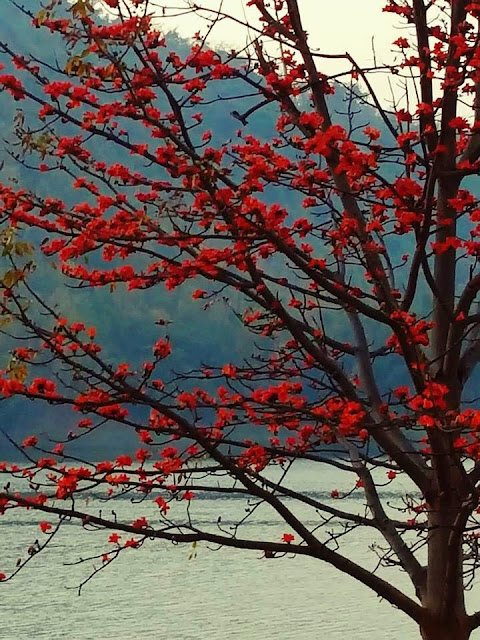Colours of Karnataka- Folk dance...
“Of
all the arts, none remain as rooted in ritual as dance.”- Anonymous
The
reverberating sounds of ankle bells infused with graceful movements. The
colourful costumes creating an enthralling effect upon its onlookers, the
compelling expressions unfolding the hidden tales just like a gush of free
flowing river that does not know to halt!
Dance
is the manifestation of enunciating at its purest form. It sets the dancers
soul free to express and reveal their invincible spirit. Dance is not merely
the movement of body; instead it portrays the divinity of one’s exalted soul.
History bear witness to several kind of dances, which along with their cultural
aspects were performed to please gods and goddesses.
Out
of the innumerable forms of dance one such is folk dance. Folk dances are fine
exemplification of rich culture, tradition and diversity of various communities
and ethnicities. They have a distinct characterization with their astounding
spontaneity and vivaciousness with which they are performed. Folk dances are
the epitome of the three significant facets in a dance, that is, expressions,
emotions and feelings.
Even
though it has a unique way of presentation, unfortunately, the folk culture is
losing its grip in the current scenario. With the emergence of new mode of
dance styles, its sustenance is becoming a challenge for the government. But a
folk dance has much more to impart through its performance than alone a
platform of entertainment.
Karnataka’s
folk dance preserves a plethora of age-old charm in its bosom. The brilliant
concept, the vibrant costumes and the enchanting story line, promises to
captivate its spectators through their vigour and exuberance. The state along
with its strong aesthetic appeal also boasts an exceptional figure of folk
dances, which is approximately eighteen in number! The main dances include Huli
Vesha (Tiger dance), Dollu-Kunitha, Kamsale, Veergase dance.
A
fascinating drum dance which is accompanied with singing, Dollu Kunitha pledges
to be a prominent dance of Karnataka. It not only provides a spectacular
variety and complexity of skills in the process of demonstration. But also puts
across entertainment and spiritual elucidation. The performance is woven around
the presiding deity of Beereshwara that is chiefly worshipped by the Kuruba
Gowdas of Karnataka and Andhra Pradesh. It is a semicircular dance usually
performed by the men of the shepherd community, and the music is from the
traditional instrument called the Dollu, which produces a thunderous sound. The
drums are decorated with colored cloth and are slanged around the necks of the
percussionists. Other musical instruments used for the dance are cymbals and
flute. The powerful drumming, energetic movements, and the coordinated group
formations make the dance form more attractive.
An
exclusionary folk dance that poses to the Tulu Nadu region of Karnataka,
Hulivesha predominantly known as Tiger Dance is performed during Dussera to
honour the Goddess Sharada, whose favoured animal is the tiger. As the name
proposes ‘tiger dance’, the characters also are painted with the motif of a
leopard or cheetah. Each person will be wearing just knickers which usually
have a tiger skin motif. The rest of his bare body and face is painted with
various designs that denote tigers, cheetahs and leopards. A mask made of fake
fur and sometimes a tail is worn to complete the ensemble.
Karnataka’s
inimitable folk art Kamsale, performed by the devotees of Lord Mahadeshwara is
popularly known as ‘Devaraguddas’. Kamsale is named after a brass musical
instrument held in the dancers’ hands. This instrument comprises a shoola held
in one hand and a bronze disc in the other. The main element in the art is the
rhythmic clang which blends with melodious music of the Lord Mahadeswara epic.
The instruments, in the course of the vigorous rhythmic beatings are moved
around the body of the dancer in countless patterns manifesting both skill and
art. In a group movement the dancer provides the vision of a series of offensive
and defensive manoeuvres. Kamsale is closely connected with a tradition of
Shiva worship. The artists who have vowed to live a life of devotion to lord
Mahadeswara are supposed to performs Kamsale.
The
symbolic presentation of the heroism and valour of God Veerabhadra is
prevalently represented in the form of Veeragase folk dance. Its exponents are
called Lingadevaru and they perform the dance with religious fervour at
festival time especially during the months of Shravana and Kartika. The dancers
put on white turban like head gear and wear kavi coloured dhotis,
rudrakshamala, nagabharanas and a wooden plaque of Lord Veerabhadra on their
chest and smear their forehead ears and eye brows with vibhooti. Sporting an
unsheathed sword in the right hand and a wooden plaque of Veerabhadra in the
left hand, the dancers perform a martial dance to the beat of Karadi and chamel
drums.
In
an effort to keep classical folk arts alive, students from classes nine and
twelve from aided and government schools across the State will document the
history of these art forms, communities involved in them, their costumes and so
on. The students are expected to interview artistes, artisans, take photographs
and videos.
The
Ministry of Human Resource Development initiates to promote arts in education
among high school students which will be a part of the Kala Utsav project. The
students will also have to complete an online art project where the art form
chosen is documented and put on social networking platforms such as Facebook, Twitter,
and Instagram.
The
folk culture and its authentic representation of sheer traditions are beyond
time. It comprises of a charm that is irreplaceable. Dance, be it in any form,
is something which connects with the soul and thus cannot die. As they say it,
“It is with your feet that you move but it’s with your heart that you dance!”

Comments
Post a Comment